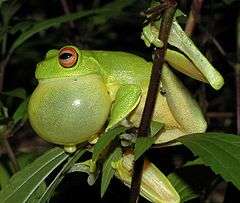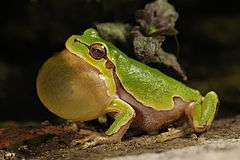Vocal sac
The vocal sac is the flexible membrane of skin possessed by most male frogs. The purpose of the vocal sac is usually as an amplification of their mating or advertisement call. The presence or development of the vocal sac is one way of externally determining the sex of a frog in many species.


The vocal sac is open to the mouth cavity of the frog, with two slits on either side of the tongue. To call, the frog inflates its lungs and shuts its nose and mouth. Air is then expelled from the lungs, through the larynx, and into the vocal sac. The vibrations of the larynx emits a sound, which resonates on the elastic membrane of the vocal sac.[1] The resonance causes the sound to be amplified and allows the call to carry further. Muscles within the body wall force the air back and forth between the lungs and vocal sac.
Development
The development of the vocal sac is different in most species, however they mostly follow the same process. The development of the unilobular vocal sac begins with two small growths on the floor of the mouth. These grow until they form two small pouches, which expand until they meet in the centre of the mouth and form one large cavity, which then grows until it is fully developed.
Purpose
The primary purpose of the vocal sac is to amplify the advertisement call of the male, and attract females from as large an area as possible. Species of frog without vocal sacs may only be heard within a radius of a few metres, whereas some species with vocal sacs can be heard over 1 km (0.62 mi) away. Modern frog species (neobatrachians and some mesobatrachians) which lack vocal sacs tend to inhabit areas close to flowing water. The sound of the flowing water overpowers the advertisement call, so they must advertise by other means.
An alternative use of the vocal sac is employed by the frogs of the family Rhinodermatidae. The males of the two species of this family scoop recently hatched tadpoles into their mouth, where they move into the vocal sac. The tadpoles of Darwin's frog (Rhinoderma darwinii) remain in the vocal sac until metamorphosis, whereas the Chile Darwin's frog (Rhinoderma rufum) will transport the tadpoles to a water source.
See also
- Throat sac
- Animal communication
References
- Purgue, Alejandro. "Sound radiation and post-glottal filtering in frogs: Vocal Sac Resonators Revisited". acoustics.org. Acoustical Society of America. Retrieved 13 May 2019.
- Tyler, M. J. (1994). Australian Frogs A Natural History. Reed Books. ISBN 0-7301-0468-0.
- "The Seattle Times: Natural Wonders". Retrieved 2006-06-15.
- Cogger, H.G.; R.G. Zweifel; D. Kirschner (2004). Encyclopedia of Reptiles & Amphibians Second Edition. Fog City Press. ISBN 1-877019-69-0.
- Duellman, Willam E.; Linda Truels (1994). Biology of Amphibians. The Johns Hopkins University Press. ISBN 080184780X.
- "Anurans – Vocal". Archived from the original on 2004-08-22. Retrieved 2006-06-19.